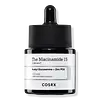What's inside
What's inside
 Key Ingredients
Key Ingredients

 Benefits
Benefits

 Concerns
Concerns

No concerns
 Ingredients Side-by-side
Ingredients Side-by-side

Water
Skin ConditioningCitrus Limon Fruit Water
MaskingLactobacillus Ferment
Skin ConditioningGlycerin
HumectantGlyceryl Stearate Citrate
EmollientCetearyl Alcohol
EmollientCopaifera Officinalis Resin
MaskingZinc PCA
HumectantAleurites Moluccanus Seed Oil
Skin ConditioningEuterpe Oleracea Fruit Oil
Skin ConditioningSodium Hyaluronate
HumectantCarapa Guaianensis Seed Oil
Skin ConditioningSqualene
EmollientSodium Levulinate
Skin ConditioningAcacia Senegal Gum
MaskingSodium Anisate
AntimicrobialXanthan Gum
EmulsifyingGlyceryl Caprylate
EmollientFoeniculum Vulgare Oil
EmollientCitrus Aurantium Dulcis Peel Oil
MaskingBeta-Sitosterol
Emulsion StabilisingTocopherol
AntioxidantLactic Acid
BufferingWater, Citrus Limon Fruit Water, Lactobacillus Ferment, Glycerin, Glyceryl Stearate Citrate, Cetearyl Alcohol, Copaifera Officinalis Resin, Zinc PCA, Aleurites Moluccanus Seed Oil, Euterpe Oleracea Fruit Oil, Sodium Hyaluronate, Carapa Guaianensis Seed Oil, Squalene, Sodium Levulinate, Acacia Senegal Gum, Sodium Anisate, Xanthan Gum, Glyceryl Caprylate, Foeniculum Vulgare Oil, Citrus Aurantium Dulcis Peel Oil, Beta-Sitosterol, Tocopherol, Lactic Acid
 Reviews
Reviews

Ingredients Explained
These ingredients are found in both products.
Ingredients higher up in an ingredient list are typically present in a larger amount.
Tocopherol (also known as Vitamin E) is a common antioxidant used to help protect the skin from free-radicals and strengthen the skin barrier. It's also fat soluble - this means our skin is great at absorbing it.
Vitamin E also helps keep your natural skin lipids healthy. Your lipid skin barrier naturally consists of lipids, ceramides, and fatty acids. Vitamin E offers extra protection for your skin’s lipid barrier, keeping your skin healthy and nourished.
Another benefit is a bit of UV protection. Vitamin E helps reduce the damage caused by UVB rays. (It should not replace your sunscreen). Combining it with Vitamin C can decrease sunburned cells and hyperpigmentation after UV exposure.
You might have noticed Vitamin E + C often paired together. This is because it is great at stabilizing Vitamin C. Using the two together helps increase the effectiveness of both ingredients.
There are often claims that Vitamin E can reduce/prevent scarring, but these claims haven't been confirmed by scientific research.
Learn more about TocopherolWater. It's the most common cosmetic ingredient of all. You'll usually see it at the top of ingredient lists, meaning that it makes up the largest part of the product.
So why is it so popular? Water most often acts as a solvent - this means that it helps dissolve other ingredients into the formulation.
You'll also recognize water as that liquid we all need to stay alive. If you see this, drink a glass of water. Stay hydrated!
Learn more about WaterXanthan gum is used as a stabilizer and thickener within cosmetic products. It helps give products a sticky, thick feeling - preventing them from being too runny.
On the technical side of things, xanthan gum is a polysaccharide - a combination consisting of multiple sugar molecules bonded together.
Xanthan gum is a pretty common and great ingredient. It is a natural, non-toxic, non-irritating ingredient that is also commonly used in food products.
Learn more about Xanthan GumZinc PCA (or "zinc salt") differs slightly from zinc itself. PCA stands for pyrrolidone carboxylic acid. However, Zinc PCA comes from zinc.
It can help reduce redness, regulate sebum, and promote the general healing process of the skin.
Zinc PCA tends to be especially useful for those with oily, acne-prone skin. It's certainly an ingredient worth trying out!
Learn more about Zinc PCA